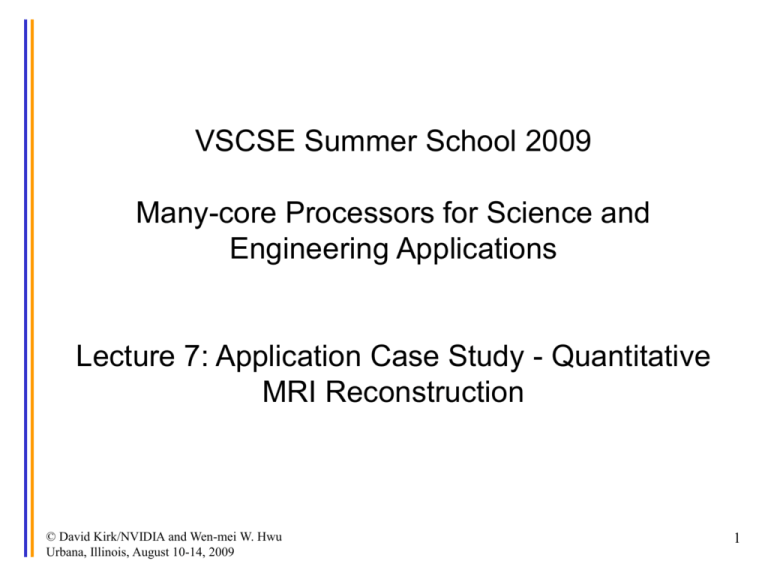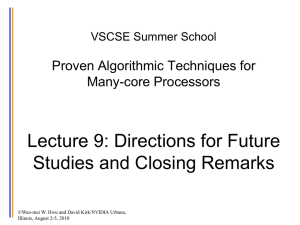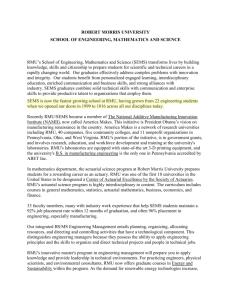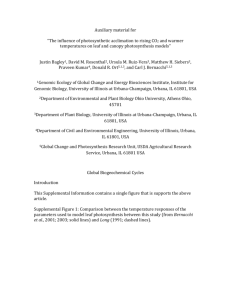lecture7 case study 2009
advertisement

VSCSE Summer School 2009
Many-core Processors for Science and
Engineering Applications
Lecture 7: Application Case Study - Quantitative
MRI Reconstruction
© David Kirk/NVIDIA and Wen-mei W. Hwu
Urbana, Illinois, August 10-14, 2009
1
Objective
• To learn about computational thinking skills through a
concrete example
–
–
–
–
Problem formulation
Designing implementations to steer around limitations
Validating results
Understanding the impact of your improvements
• A top to bottom experience!
© David Kirk/NVIDIA and Wen-mei W. Hwu
Urbana, Illinois, August 10-14, 2009
2
The Illinois MRI Acceleration Team
Faculty
Students
•Zhi-Pei Liang
•Brad Sutton
•Keith Thulborn
•Ian Atkinson
•Justin Haldar
•Yue Zhuo
•Fan Lam
•Wen-mei Hwu
•John Stone
•Sam Stone
•Deepthi Nandakumar
•Xiao-Long Wu
•Nady Obeid
•Haoran Yi
•Stephanie Tsao
© David Kirk/NVIDIA and Wen-mei W. Hwu
Urbana, Illinois, August 10-14, 2009
3
MRI Pipeline
Speedup can
enable new
applications
Interpretation
Data
Acquisition
Image
Reconstruction
GPU
© David Kirk/NVIDIA and Wen-mei W. Hwu
Urbana, Illinois, August 10-14, 2009
Parameter
Estimation
GPU
4
MRI data in Fourier Space
• Ignoring several effects, MRI image and signal are a
Fourier transform pair
true image
data samples
© David Kirk/NVIDIA and Wen-mei W. Hwu
Urbana, Illinois, August 10-14, 2009
Fourier kernel
noise
5
Discretization
• Infinite dimensional variables are inconvenient for
computation
Finite dimensional
image representation
voxel basis function
Integral equation
Matrix equation
© David Kirk/NVIDIA and Wen-mei W. Hwu
Urbana, Illinois, August 10-14, 2009
6
Very Large Matrix Equations
• Typical 2D images: N of ρ =256x256
• Typical 3D images: N of ρ =256x256x256
If thinking in megapixels – this is a low res camera
F Matrix entries are complex floats, so storage of matrix (single precision):
2D: dimension of F is (256X256)2 ~ 34 GB
3D: (256X256X256)3 ~ 2 PB
© David Kirk/NVIDIA and Wen-mei W. Hwu
Urbana, Illinois, August 10-14, 2009
7
Reconstructing Fourier Data
• Two main approaches:
– Riemann approximation of the continuous inverse FT:
density compensation
ρˆ F
H
w
M
d wm d m e
i 2 k m x
m 1
– Solve a regularized inverse problem, e.g.,
ρˆ arg min Fρ d 2 R ρ
2
ρ
Solutions often derived by solving one or more matrix inversions, e.g.,
ˆρ F F H F H d
H
© David Kirk/NVIDIA and Wen-mei W. Hwu
Urbana, Illinois, August 10-14, 2009
1
8
Reconstructing MR Images
Cartesian Scan Data
ky
kx
Spiral Scan Data
ky
Gridding1
kx
ky
kx
FFT
LS
Spiral scan data + Gridding + FFT:
Fast scan, fast reconstruction, better images
1
Based on Fig 1 of Lustig et al, Fast Spiral Fourier Transform for Iterative MR Image Reconstruction, IEEE Int’l Symp. on Biomedical Imaging, 2004
© David Kirk/NVIDIA and Wen-mei W. Hwu
Urbana, Illinois, August 10-14, 2009
9
Reconstructing MR Images
Cartesian Scan Data
ky
Spiral Scan Data
ky
Gridding
kx
kx
ky
kx
FFT
Least-Squares (LS)
Spiral scan data + LS
Superior images at expense of significantly more computation
© David Kirk/NVIDIA and Wen-mei W. Hwu
Urbana, Illinois, August 10-14, 2009
10
An Exciting Revolution - Sodium Map of
the Brain
• Images of sodium in the brain
– Very large number of samples for increased SNR
– Requires high-quality reconstruction
• Enables study of brain-cell viability before anatomic changes
occur in stroke and cancer treatment – within days!
Courtesy of Keith Thulborn and Ian Atkinson, Center for MR Research, University of Illinois at Chicago
© David Kirk/NVIDIA and Wen-mei W. Hwu
Urbana, Illinois, August 10-14, 2009
11
Least-Squares Reconstruction
F F F d
H
Compute Q = FHF
Acquire Data
Compute FHd
Find ρ
© David Kirk/NVIDIA and Wen-mei W. Hwu
Urbana, Illinois, August 10-14, 2009
H
• Q depends only on scanner
configuration
H
• F d depends on scan data
• ρ found using linear solver
• Accelerate Q and FHd on G80
– Q: 1-2 days on CPU
– FHd: 6-7 hours on CPU
– ρ: 1.5 minutes on CPU
12
Algorithms to Accelerate
for (m = 0; m < M; m++) {
rMu[m] = rPhi[m]*rD[m] +
iPhi[m]*iD[m];
iMu[m] = rPhi[m]*iD[m] –
iPhi[m]*rD[m];
for (n = 0; n < N; n++) {
expFhD = 2*PI*(kx[m]*x[n] +
ky[m]*y[n] +
kz[m]*z[n]);
cArg = cos(expFhD);
sArg = sin(expFhD);
rFhD[n] +=
iFhD[n] +=
rMu[m]*cArg –
iMu[m]*sArg;
iMu[m]*cArg +
rMu[m]*sArg;
}
©}David Kirk/NVIDIA and Wen-mei W. Hwu
Urbana, Illinois, August 10-14, 2009
• Scan data
– M = # scan points
– kx, ky, kz = 3D scan data
• Pixel data
– N = # pixels
– x, y, z = input 3D pixel
data
– rFhD, iFhD= output
pixel data
• Complexity is O(MN)
• Inner loop
– 13 FP MUL or ADD ops
– 2 FP trig ops
– 12 loads, 2 stores
13
From C to CUDA: Step 1
What unit of work is assigned to each thread?
for (m = 0; m < M; m++) {
rMu[m] = rPhi[m]*rD[m] + iPhi[m]*iD[m];
iMu[m] = rPhi[m]*iD[m] – iPhi[m]*rD[m];
for (n =
expFhD
cArg =
sArg =
0; n < N; n++) {
= 2*PI*(kx[m]*x[n] + ky[m]*y[n] + kz[m]*z[n]);
cos(expFhD);
sin(expFhD);
rFhD[n] +=
iFhD[n] +=
rMu[m]*cArg – iMu[m]*sArg;
iMu[m]*cArg + rMu[m]*sArg;
}
}
© David Kirk/NVIDIA and Wen-mei W. Hwu
Urbana, Illinois, August 10-14, 2009
14
One Possibility
__global__ void cmpFHd(float* rPhi, iPhi, phiMag,
kx, ky, kz, x, y, z, rMu, iMu, int N) {
int m = blockIdx.x * FHD_THREADS_PER_BLOCK + threadIdx.x;
rMu[m] = rPhi[m]*rD[m] + iPhi[m]*iD[m];
iMu[m] = rPhi[m]*iD[m] – iPhi[m]*rD[m];
for (n = 0; n < N; n++) {
expFhD = 2*PI*(kx[m]*x[n] + ky[m]*y[n] + kz[m]*z[n]);
cArg = cos(expFhD);
rFhD[n] +=
iFhD[n] +=
sArg = sin(expFhD);
rMu[m]*cArg – iMu[m]*sArg;
iMu[m]*cArg + rMu[m]*sArg;
}
}
© David Kirk/NVIDIA and Wen-mei W. Hwu
Urbana, Illinois, August 10-14, 2009
15
One Possibility - Improved
__global__ void cmpFHd(float* rPhi, iPhi, phiMag,
kx, ky, kz, x, y, z, rMu, iMu, int N) {
int m = blockIdx.x * FHD_THREADS_PER_BLOCK + threadIdx.x;
float rMu_reg, iMu_reg;
rMu_reg = rMu[m] = rPhi[m]*rD[m] + iPhi[m]*iD[m];
iMu_reg = iMu[m] = rPhi[m]*iD[m] – iPhi[m]*rD[m];
for (n = 0; n < N; n++) {
expFhD = 2*PI*(kx[m]*x[n] + ky[m]*y[n] + kz[m]*z[n]);
cArg = cos(expFhD);
rFhD[n] +=
iFhD[n] +=
sArg = sin(expFhD);
rMu_reg*cArg – iMu_reg*sArg;
iMu_reg*cArg + rMu_reg*sArg;
}
}
© David Kirk/NVIDIA and Wen-mei W. Hwu
Urbana, Illinois, August 10-14, 2009
16
Back to the Drawing Board – Maybe map the
n loop to threads?
for (m = 0; m < M; m++) {
rMu[m] = rPhi[m]*rD[m] + iPhi[m]*iD[m];
iMu[m] = rPhi[m]*iD[m] – iPhi[m]*rD[m];
for (n =
expFhD
cArg =
sArg =
0; n < N; n++) {
= 2*PI*(kx[m]*x[n] + ky[m]*y[n] + kz[m]*z[n]);
cos(expFhD);
sin(expFhD);
rFhD[n] +=
iFhD[n] +=
rMu[m]*cArg – iMu[m]*sArg;
iMu[m]*cArg + rMu[m]*sArg;
}
}
© David Kirk/NVIDIA and Wen-mei W. Hwu
Urbana, Illinois, August 10-14, 2009
17
for (m = 0; m < M; m++) {
for (m = 0; m < M; m++) {
for (n = 0; n < N; n++) {
rMu[m] = rPhi[m]*rD[m] +
iPhi[m]*iD[m];
iMu[m] = rPhi[m]*iD[m] –
iPhi[m]*rD[m];
rMu[m] = rPhi[m]*rD[m] +
iPhi[m]*iD[m];
iMu[m] = rPhi[m]*iD[m] –
iPhi[m]*rD[m];
expFhD = 2*PI*(kx[m]*x[n] +
ky[m]*y[n] +
kz[m]*z[n]);
for (n = 0; n < N; n++) {
expFhD = 2*PI*(kx[m]*x[n] +
ky[m]*y[n] +
kz[m]*z[n]);
cArg = cos(expFhD);
sArg = sin(expFhD);
cArg = cos(expFhD);
sArg = sin(expFhD);
rFhD[n] +=
iFhD[n] +=
rFhD[n] +=
rMu[m]*cArg –
iMu[m]*sArg;
iMu[m]*cArg +
rMu[m]*sArg;
}
iFhD[n] +=
}
}
}
rMu[m]*cArg –
iMu[m]*sArg;
iMu[m]*cArg +
rMu[m]*sArg;
(b) after code motion
(a) FHd computation
© David Kirk/NVIDIA and Wen-mei W. Hwu
Urbana, Illinois, August 10-14, 2009
18
A Second Option for the cmpFHd Kernel
__global__ void cmpFHd(float* rPhi, iPhi, phiMag,
kx, ky, kz, x, y, z, rMu, iMu, int N) {
int n = blockIdx.x * FHD_THREADS_PER_BLOCK + threadIdx.x;
for (m = 0; m < M; m++) {
float rMu_reg = rMu[m] = rPhi[m]*rD[m] + iPhi[m]*iD[m];
float iMu_reg = iMu[m] = rPhi[m]*iD[m] – iPhi[m]*rD[m];
float expFhD = 2*PI*(kx[m]*x[n]+ky[m]*y[n]+kz[m]*z[n]);
float cArg = cos(expFhD);
float sArg = sin(expFhD);
rFhD[n] +=
iFhD[n] +=
rMu_reg*cArg – iMu_reg*sArg;
iMu_reg*cArg + rMu_reg*sArg;
}
}
© David Kirk/NVIDIA and Wen-mei W. Hwu
Urbana, Illinois, August 10-14, 2009
19
We do have another option.
© David Kirk/NVIDIA and Wen-mei W. Hwu
Urbana, Illinois, August 10-14, 2009
20
for (m = 0; m < M; m++) {
for (m = 0; m < M; m++) {
rMu[m] = rPhi[m]*rD[m] +
iPhi[m]*iD[m];
iMu[m] = rPhi[m]*iD[m] –
iPhi[m]*rD[m];
for (n = 0; n < N; n++) {
expFhD = 2*PI*(kx[m]*x[n] +
ky[m]*y[n] +
kz[m]*z[n]);
rMu[m] = rPhi[m]*rD[m] +
iPhi[m]*iD[m];
iMu[m] = rPhi[m]*iD[m] –
iPhi[m]*rD[m];
}
for (m = 0; m < M; m++) {
for (n = 0; n < N; n++) {
expFhD = 2*PI*(kx[m]*x[n] +
ky[m]*y[n] +
kz[m]*z[n]);
cArg = cos(expFhD);
sArg = sin(expFhD);
rFhD[n] +=
iFhD[n] +=
cArg = cos(expFhD);
sArg = sin(expFhD);
rMu[m]*cArg –
iMu[m]*sArg;
iMu[m]*cArg +
rMu[m]*sArg;
rFhD[n] +=
iFhD[n] +=
}
}
rMu[m]*cArg –
iMu[m]*sArg;
iMu[m]*cArg +
rMu[m]*sArg;
}
(a) FHd computation
© David Kirk/NVIDIA and Wen-mei W. Hwu
Urbana, Illinois, August 10-14, 2009
}
(b) after loop fission
21
A Separate cmpMu Kernel
__global__ void cmpMu(float* rPhi, iPhi, rD, iD, rMu, iMu)
{
int m = blockIdx.x * MU_THREAEDS_PER_BLOCK + threadIdx.x;
rMu[m] = rPhi[m]*rD[m] + iPhi[m]*iD[m];
iMu[m] = rPhi[m]*iD[m] – iPhi[m]*rD[m];
}
© David Kirk/NVIDIA and Wen-mei W. Hwu
Urbana, Illinois, August 10-14, 2009
22
__global__ void cmpFHd(float* rPhi, iPhi, phiMag,
kx, ky, kz, x, y, z, rMu, iMu, int N) {
int m = blockIdx.x * FHD_THREADS_PER_BLOCK + threadIdx.x;
for (n = 0; n < N; n++) {
float expFhD = 2*PI*(kx[m]*x[n]+ky[m]*y[n]+kz[m]*z[n]);
float cArg = cos(expFhD);
float sArg = sin(expFhD);
rFhD[n] +=
iFhD[n] +=
rMu[m]*cArg – iMu[m]*sArg;
iMu[m]*cArg + rMu[m]*sArg;
}
}
© David Kirk/NVIDIA and Wen-mei W. Hwu
Urbana, Illinois, August 10-14, 2009
23
for (m = 0; m < M; m++) {
for (n = 0; n < N; n++) {
expFhD = 2*PI*(kx[m]*x[n] +
ky[m]*y[n] +
kz[m]*z[n]);
for (n = 0; n < N; n++) {
for (m = 0; m < M; m++) {
expFhD = 2*PI*(kx[m]*x[n] +
ky[m]*y[n] +
kz[m]*z[n]);
cArg = cos(expFhD);
sArg = sin(expFhD);
cArg = cos(expFhD);
sArg = sin(expFhD);
rFhD[n] +=
rFhD[n] +=
iFhD[n] +=
rMu[m]*cArg –
iMu[m]*sArg;
iMu[m]*cArg +
rMu[m]*sArg;
}
} (a) before loop interchange
iFhD[n] +=
rMu[m]*cArg –
iMu[m]*sArg;
iMu[m]*cArg +
rMu[m]*sArg;
}
} (b) after loop interchange
Figure 7.9 Loop interchange of the FHD computation
© David Kirk/NVIDIA and Wen-mei W. Hwu
Urbana, Illinois, August 10-14, 2009
24
A Third Option of FHd Kernel
__global__ void cmpFHd(float* rPhi, iPhi, phiMag,
kx, ky, kz, x, y, z, rMu, iMu, int M) {
int n = blockIdx.x * FHD_THREADS_PER_BLOCK + threadIdx.x;
for (m = 0; m < M; m++) {
float expFhD = 2*PI*(kx[m]*x[n]+ky[m]*y[n]+kz[m]*z[n]);
float cArg = cos(expFhD);
float sArg = sin(expFhD);
rFhD[n] +=
iFhD[n] +=
rMu[m]*cArg – iMu[m]*sArg;
iMu[m]*cArg + rMu[m]*sArg;
}
}
© David Kirk/NVIDIA and Wen-mei W. Hwu
Urbana, Illinois, August 10-14, 2009
25
Using Registers to Reduce Global Memory
Traffic
__global__ void cmpFHd(float* rPhi, iPhi, phiMag,
kx, ky, kz, x, y, z, rMu, iMu, int M) {
int n = blockIdx.x * FHD_THREADS_PER_BLOCK + threadIdx.x;
float xn_r = x[n]; float yn_r = y[n]; float zn_r = z[n];
float rFhDn_r = rFhD[n]; float iFhDn_r = iFhD[n];
for (m = 0; m < M; m++) {
float expFhD = 2*PI*(kx[m]*xn_r+ky[m]*yn_r+kz[m]*zn_r);
float cArg = cos(expFhD);
float sArg = sin(expFhD);
rFhDn_r +=
iFhDn_r +=
rMu[m]*cArg – iMu[m]*sArg;
iMu[m]*cArg + rMu[m]*sArg;
}
rFhD[n] = rFhD_r; iFhD[n] = iFhD_r;
}
© David Kirk/NVIDIA and Wen-mei W. Hwu
Urbana, Illinois, August 10-14, 2009
26
Chunking k-space Data to Fit into Constant
Memory
__constant__ float
kx_c[CHUNK_SIZE],
ky_c[CHUNK_SIZE], kz_c[CHUNK_SIZE];
…
__ void main() {
int i;
for (i = 0; i < M/CHUNK_SIZE; i++);
cudaMemcpy(kx_c,&kx[i*CHUNK_SIZE],4*CHUNK_SIZE,
cudaMemCpyHostToDevice);
cudaMemcpy(ky_c,&ky[i*CHUNK_SIZE],4*CHUNK_SIZE,
cudaMemCpyHostToDevice);
cudaMemcpy(ky_c,&ky[i*CHUNK_SIZE],4*CHUNK_SIZE,
cudaMemCpyHostToDevice);
…
cmpFHD<<<FHD_THREADS_PER_BLOCK, N/FHD_THREADS_PER_BLOCK>>>
(rPhi, iPhi, phiMag, x, y, z, rMu, iMu, int M);
}
/* Need to call kernel one more time if M is not */
© /*
David perfect
Kirk/NVIDIA andmultiple
Wen-mei W. Hwu of CHUNK SIZE */
27
} Urbana, Illinois, August 10-14, 2009
Revised Kernel for Constant Memory
__global__ void cmpFHd(float* rPhi, iPhi, phiMag,
x, y, z, rMu, iMu, int M) {
int n = blockIdx.x * FHD_THREADS_PER_BLOCK + threadIdx.x;
float xn_r = x[n]; float yn_r = y[n]; float zn_r = z[n];
float rFhDn_r = rFhD[n]; float iFhDn_r = iFhD[n];
for (m = 0; m < M; m++) {
float expFhD = 2*PI*(kx[m]*xn_r+ky[m]*yn_r+kz[m]*zn_r);
float cArg = cos(expFhD);
float sArg = sin(expFhD);
rFhDn_r +=
iFhDn_r +=
rMu[m]*cArg – iMu[m]*sArg;
iMu[m]*cArg + rMu[m]*sArg;
}
rFhD[n] = rFhD_r; iFhD[n] = iFhD_r;
}
© David Kirk/NVIDIA and Wen-mei W. Hwu
Urbana, Illinois, August 10-14, 2009
28
K-space Data Layout in Constant Memory
kx[i]
ky[i]
ky[i]
phi[i]
Scan Data
kx
ky
kz
phi
Constant Memory
(a) k-space data stored in separate arrays.
© David Kirk/NVIDIA and Wen-mei W. Hwu
Urbana, Illinois, August 10-14, 2009
Scan Data
kx[i] ky[i] kz[i] phi[i]
Constant Memory
(b) k-space data stored in an array
whose elements are structs.
29
K-Space Layout Host Code
struct kdata {
float x, float y, float z;
} k;
__constant__ struct kdata k_c[CHUNK_SIZE];
…
__ void main() {
int i;
for (i = 0; i < M/CHUNK_SIZE; i++);
cudaMemcpy(k_c,k,12*CHUNK_SIZE, cudaMemCpyHostToDevice);
cmpFHD<<<FHD_THREADS_PER_BLOCK,N/FHD_THREADS_PER_BLOCK>>>
();
}
© David Kirk/NVIDIA and Wen-mei W. Hwu
Urbana, Illinois, August 10-14, 2009
30
K-Space Layout Kernel Code
__global__ void cmpFHd(float* rPhi, iPhi, phiMag,
x, y, z, rMu, iMu, int M) {
int n = blockIdx.x * FHD_THREADS_PER_BLOCK + threadIdx.x;
float xn_r = x[n]; float yn_r = y[n]; float zn_r = z[n];
float rFhDn_r = rFhD[n]; float iFhDn_r = iFhD[n];
for (m = 0; m < M; m++) {
float expFhD = 2*PI*(k[m].x*xn_r+k[m].y*yn_r+k[m].z*zn_r);
float cArg = cos(expFhD);
float sArg = sin(expFhD);
rFhDn_r +=
iFhDn_r +=
rMu[m]*cArg – iMu[m]*sArg;
iMu[m]*cArg + rMu[m]*sArg;
}
rFhD[n] = rFhD_r; iFhD[n] = iFhD_r;
}
© David Kirk/NVIDIA and Wen-mei W. Hwu
Urbana, Illinois, August 10-14, 2009
31
Sidebar: Estimating Off-Chip Loads with
Const Cache
• How can we approximate the number of off-chip loads when using the constant
caches?
• Given: 128 threads per block, 4 blocks per SM, 256 scan points per grid
• Assume no evictions due to cache conflicts
• 7 accesses to global memory per thread (x, y, z, rQ x 2, iQ x 2)
– 4 blocks/SM * 128 threads/block * 7 accesses/thread = 3,584 global mem accesses
• 4 accesses to constant memory per scan point (kx, ky, kz, phi)
– 256 scan points * 4 loads/point = 1,024 constant mem accesses
• Total off-chip memory accesses = 3,584 + 1,024 = 4,608
• Total FP arithmetic ops = 4 blocks/SM * 128 threads/block * 256 iters/thread *
10 ops/iter = 1,310,720
• FP arithmetic to off-chip loads: 284 to 1
© David Kirk/NVIDIA and Wen-mei W. Hwu
Urbana, Illinois, August 10-14, 2009
32
Sidebar: Effects of Approximations
• Avoid temptation to measure only absolute error (I0 – I)
– Can be deceptively large or small
• Metrics
– PSNR: Peak signal-to-noise ratio
– SNR: Signal-to-noise ratio
• Avoid temptation to consider only the error in the computed value
– Some apps are resistant to approximations; others are very sensitive
1
2
MSE
(
I
(
i
,
j
)
I
(
i
,
j
))
0
mn i j
PSNR 20 log 10 (
max( I 0 (i, j ))
MSE
)
As
1
I 0 (i, j ) 2
mn i j
SNR 20 log 10 (
As
MSE
)
A.N. Netravali and B.G. Haskell, Digital Pictures: Representation, Compression, and Standards (2nd Ed), Plenum Press, New York, NY (1995).
© David Kirk/NVIDIA and Wen-mei W. Hwu
Urbana, Illinois, August 10-14, 2009
33
Validation of floating-point
precision and accuracy of the
different FHd implementations.
© David Kirk/NVIDIA and Wen-mei W. Hwu
Urbana, Illinois, August 10-14, 2009
34
Sidebar: Optimizing the CPU
Implementation
• Optimizing the CPU implementation of your application is very
important
– Often, the transformations that increase performance on CPU also increase
performance on GPU (and vice-versa)
– The research community won’t take your results seriously if your baseline
is crippled
• Useful optimizations
–
–
–
–
Data tiling
SIMD vectorization (SSE)
Fast math libraries (AMD, Intel)
Classical optimizations (loop unrolling, etc)
• Intel compiler (icc, icpc)
© David Kirk/NVIDIA and Wen-mei W. Hwu
Urbana, Illinois, August 10-14, 2009
35
Summary of Results
FHd
Q
Reconstruction
Run
Time (m)
GFLOP
Run
Time (m)
GFLOP
Linear
Solver (m)
Recon.
Time (m)
Gridding + FFT
(CPU, DP)
N/A
N/A
N/A
N/A
N/A
0.39
LS (CPU, DP)
4009.0
0.3
518.0
0.4
1.59
519.59
LS (CPU, SP)
2678.7
0.5
342.3
0.7
1.61
343.91
260.2
5.1
41.0
5.4
1.65
42.65
LS (GPU,
CMem)
72.0
18.6
9.8
22.8
1.57
11.37
LS (GPU,
CMem,
SFU)
13.6
98.2
2.4
92.2
1.60
4.00
LS (GPU,
CMem,
SFU, Exp)
7.5
178.9
1.5
144.5
1.69
3.19
LS (GPU, Naïve)
© David Kirk/NVIDIA and Wen-mei W. Hwu
Urbana, Illinois, August 10-14, 2009
8X
36
Summary of Results
FHd
Q
Reconstruction
Run Time (m)
GFLOP
Run Time
(m)
N/A
N/A
N/A
N/A
N/A
0.39
LS (CPU, DP)
4009.0
0.3
518.0
0.4
1.59
519.59
LS (CPU, SP)
2678.7
0.5
342.3
0.7
1.61
343.91
LS (G80, Naïve)
260.2
5.1
41.0
5.4
1.65
42.65
LS (G80, CMem)
72.0
18.6
9.8
22.8
1.57
11.37
LS (G80, CMem,
SFU)
13.6
98.2
2.4
92.2
1.60
4.00
LS (G80, CMem,
SFU, Exp/layout)
7.5
178.9
1.5
144.5
1.69
3.19
Gridding + FFT
(CPU, DP)
357X
© David Kirk/NVIDIA and Wen-mei W. Hwu
Urbana, Illinois, August 10-14, 2009
228X
GFLOP
Linear
Solver (m)
Recon. Time
(m)
108X 37




